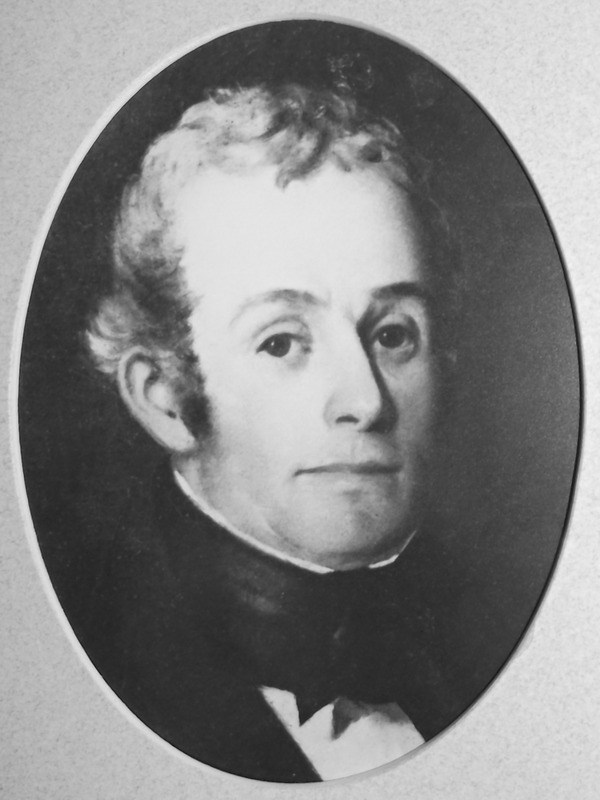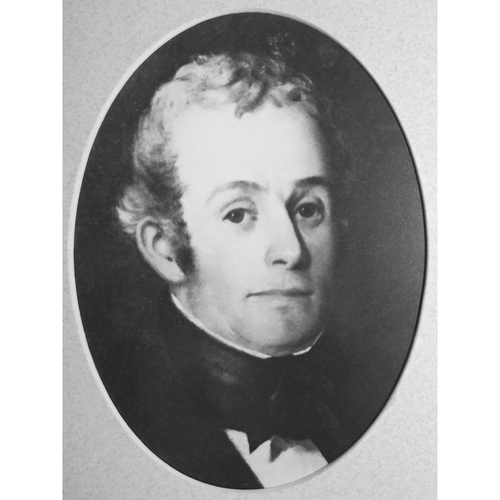
Source: Link
SIMONDS, RICHARD, businessman, politician, magistrate, and office holder; b. 24 April 1789 in Portland (Saint John), N.B., son of James Simonds* and Hannah Peabody; m. first 18 Aug. 1813 Ann Charters, and they had seven sons and one daughter; m. secondly 18 May 1829, in Annapolis Royal, N.S., Margaret Walker, widow of Lieutenant John Newton, rn; d. 2 May 1836 in Saint John.
Richard Simonds was born into one of the leading property-owning and business families in New Brunswick. After attending school in Portland, he further enhanced his prospects in life by entering into a partnership in 1810 with his maternal uncle, Francis Peabody, a merchant and shipbuilder at Miramichi. From 1819 to 1824 he also carried on business separately as a merchant, providing supplies to farmer-lumbermen and in the process acquiring many titles to property and mortgages on farms. It was almost certainly due to the influence of his uncle, who had no children of his own, that Simonds was elected to the House of Assembly as one of the two members for Northumberland County at the general election of 1816, when he was only 27 years of age. But he appears to have acquired influence in his own right in that dynamic, tempestuous, and sprawling constituency, which at the time embraced more than a third of the province. He was re-elected in 1819, 1820, and 1827. He also served as a justice of the peace and justice of the Inferior Court of Common Pleas.
In the assembly he was joined in 1820 by his elder brother Charles*, who had been elected for Saint John County and City. The two brothers, whose political careers were to be closely intertwined, became the centre of a coterie of business connections, in-laws, and cousins who favoured a more open society. They were independent parliament men, following in the footsteps of their father, James, a member in the 1790s of the party around Amos Botsford* and James Glenie* that had asserted the powers of the assembly over the appropriation of revenue and had imposed restraints on the lieutenant governor and Council. In 1821 they voted in favour of a bill to enable dissenting clergymen to perform marriages; this was carried by a majority of two but was rejected by the Council. In 1825 the votes of the two brothers were critical in defeating a measure, strongly supported by Lieutenant Governor Sir Howard Douglas*, to make financial provision for circuit courts.
Early in 1824 Richard wound up his business affairs at Miramichi, having announced his intention to move to Saint John. This plan was likely associated with the management of his father’s extensive and valuable properties, most of which he and Charles were to inherit as tenants in common in 1831. But it may have had a political as well as an economic purpose, for Richard did not settle in Saint John but in Fredericton, where he appears to have lived most of the time from 1825 to 1828.
In February 1828, at the first session of the new house following the general election of 1827, Richard Simonds was elected speaker. This was a coveted and prestigious position, for the assembly, following the traditions of the British House of Commons and the American colonial assemblies, accorded the speaker extensive authority over its proceedings. In December, after acting as speaker for only one session of the house, he resigned his seat on succeeding John Robinson* as provincial treasurer, an office that was in the gift of the lieutenant governor. His brother Charles was then unanimously elected speaker in his place.
There was at this time a convenient conjunction of the interests of the Simonds brothers and those of Lieutenant Governor Sir Howard Douglas. Douglas, an active and effective administrator, had been working since his arrival in 1824 to overcome the assembly’s tradition of obstructing initiatives of the executive, using his social magnetism to cultivate close relations with the members. By 1828 he was well aware of the political advantages of working with the Simonds brothers and knew something of the administrative abilities of Richard, who before becoming speaker had been involved in several projects in which Douglas took a direct interest, notably serving as one of the commissioners for allocating the funds raised for the relief of victims of the Miramichi fire, as supervisor of the “great” road between Fredericton and Saint John by way of the Nerepis River, and as secretary of the New-Brunswick Agricultural and Emigrant Society. Richard also shared the lieutenant governor’s interest in economic development and in the management of provincial funds. While he was speaker he held the position of paid secretary-treasurer of the agricultural and emigrant society, edited its report, and began to gather information for a report on the fisheries; he was also a member of the commission for the building of Government House.
The alliance with the Simonds brothers was not as productive as Douglas had hoped. In spite of their support he was unable to resolve imperial-provincial conflicts over the civil list, custom-house salaries, and the crown lands before leaving the province in March 1829, in part because of the dilatoriness of the British authorities and in part because the commissioner of crown lands, Thomas Baillie*, had too much influence at the Colonial Office. The one great issue that was resolved was that of assuring permanent financial provision for King’s College, Fredericton, an issue which had arisen because the British government had included in the college charter illiberal provisions that were contrary to the spirit, though not to the letter, of the non-denominational terms the assembly had insisted upon in promising support in 1823. The Simonds brothers were Anglicans, but they were tolerant of other sects and rejected the principle of Anglican exclusiveness. It is therefore ironic that, in the face of the opposition of many of the assemblymen with whom they usually associated, they supported the passing of an act in 1829 which made possible the continuing existence of what was, in effect, a thoroughly Anglican institution. A member of the Council since January 1829, Richard Simonds was clearly a participant in, and a beneficiary of, the political alignment that saddled the province with a very unpopular college. He appears to have been completely overwhelmed by Douglas’s personality at the time, expressing admiration for all of the lieutenant governor’s actions in terms more suited to a courtier than an independent parliamentarian.
At the ensuing session of the legislature in 1830, when William Black* was administering the province, the assembly included in the revenue bill a provision giving jurisdiction in smuggling cases to the justices of the peace. This clause was designed to speed up the process of seizure of illegal imports and make revenue collecting more efficient, but it also had the effect of depriving the officers of the Supreme Court of emoluments. The Council refused to give its assent and the legislature was prorogued on 8 March without provision having been made for the revenue. Simonds, who had taken leave and gone to Saint John, returned hastily to Fredericton, where at another session of the legislature called for the purpose a few days later he was able to persuade the Council to agree to the bill.
In 1831, following the election called at the death of George IV, Charles Simonds was defeated in his bid to retain the speakership of the house. By then Thomas Baillie was assuming a dominating role on the political scene, able to get his way in the Council though not always in the assembly. After the old council was abolished in late 1832, Richard Simonds was called to the new Legislative Council, and during the remaining years of his life he was consistently to be found, along with George Shore* and William Black, voting in opposition to Baillie’s policies.
Richard Simonds’s entry into the office of treasurer in December 1828 had brought a higher level of activity and organization into that department. Since the office of provincial auditor was reorganized at about the same time, management of the funds at the disposal of the assembly became much more orderly. The treasurer was essentially an employee of the assembly, responsible for collecting the revenue, keeping the accounts, managing the funds, and paying out authorized sums under warrants from the lieutenant governor. Simonds moved to Saint John in order personally to carry out his duties as collector there, and in 1832 successfully resisted an order of Lieutenant Governor Sir Archibald Campbell to move to Fredericton. He was responsible for supervising a staff of sub-collectors, one for each of the seaports and other points of entry in the province. As the chief financial officer of the legislature he was usually consulted regarding the incorporation of banks and insurance companies, and he helped in making arrangements for the placing of official funds and for the investment of company assets in the provincial debt. He remained treasurer until his death.
The Simonds brothers were the first speakers of the New Brunswick assembly to come from outside the circle of loyalist office holders. Their roots were firmly in business, though through their marriages and those of their sisters they came to have many connections with the social élite. Family background, personal interest, and wealth all contributed to their rise to positions of leadership. They seem always to have acted together in political matters, so that although Richard’s career was in itself notable, in many ways it appears to be only a prelude to that of his elder brother, who was able to continue what they had started together.
Richard Simonds died at Saint John “after a short illness” at the age of 47.
N.B. Museum, Gilbert family records, vol.4; D. R. Jack papers, folder 1 (typescript); Richard Simonds, account-book. Northumberland Land Registry Office (Newcastle, N.B.), Registry books, 1810–23, esp. 9: 54–60 (mfm. at PANB). PAC, MG 11, [CO 188] New Brunswick A, 43: 142, 149–50; MG 23, D1, 5: 217–18; MG 24, A3, R. Simonds to Douglas, March 1829; L6, 1, material on Miramichi fire, 1825; 3, N.B. Agricultural and Emigrant Soc., minute-book, no.1 (1825–30). PANB, MC 1156; RG 4, RS24, esp. S36-M3.7, S37-Z11.1–6, S42-M3; RG 7, RS71, 1831, James Simonds. UNBL, MG H11. N.B., House of Assembly, Journal, 1816–32; Legislative Council, Journal [1786–1830], vol.2, 1829–30; 1831–36. Mercury, 23 Dec. 1828. Royal Gazette (Fredericton), 10 Feb. 1824, 22 April 1828, 11 May 1836. Hill, Old Burying Ground. F. A. Firth, “King’s College, Fredericton, 1829–1859,” The University of New Brunswick memorial volume . . . , ed. A. G. Bailey (Fredericton, 1950), 22–32. D. M. Young, “The politics of higher education in the Maritimes in the 1820’s: the New Brunswick experience” (paper delivered at the Atlantic Studies Conference, Halifax, April 1980). J. McG. Baxter, “Francis Peabody, the founder of Chatham,” Miramichi Natural Hist. Assoc., Proc. (Chatham, N.B.), no.6 (1911): 35–53.
Cite This Article
D. M. Young, “SIMONDS, RICHARD,” in Dictionary of Canadian Biography, vol. 7, University of Toronto/Université Laval, 2003–, accessed January 5, 2026, https://www.biographi.ca/en/bio/simonds_richard_7E.html.
The citation above shows the format for footnotes and endnotes according to the Chicago manual of style (16th edition). Information to be used in other citation formats:
| Permalink: | https://www.biographi.ca/en/bio/simonds_richard_7E.html |
| Author of Article: | D. M. Young |
| Title of Article: | SIMONDS, RICHARD |
| Publication Name: | Dictionary of Canadian Biography, vol. 7 |
| Publisher: | University of Toronto/Université Laval |
| Year of publication: | 1988 |
| Year of revision: | 1988 |
| Access Date: | January 5, 2026 |



